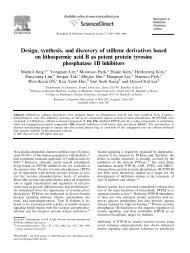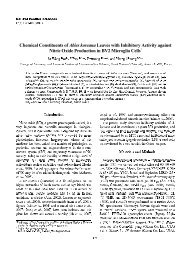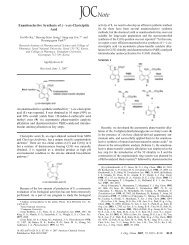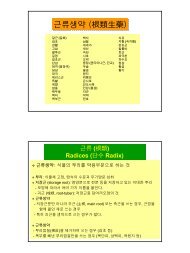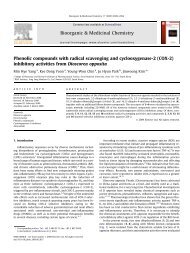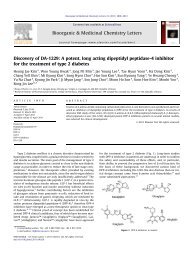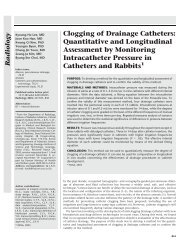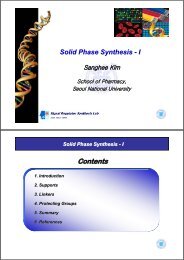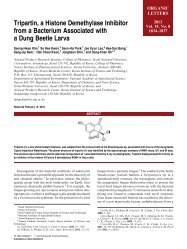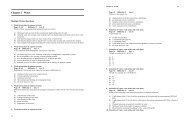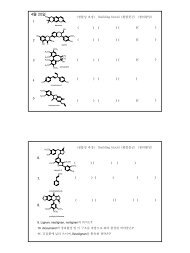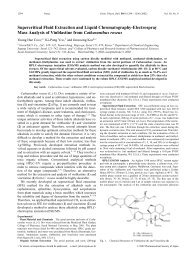Transport of anti-allergic drugs across the passage cultured human ...
Transport of anti-allergic drugs across the passage cultured human ...
Transport of anti-allergic drugs across the passage cultured human ...
Create successful ePaper yourself
Turn your PDF publications into a flip-book with our unique Google optimized e-Paper software.
206 H. Lin et al. / European Journal <strong>of</strong> Pharmaceutical Sciences 26 (2005) 203–210Fig. 1. Time-course <strong>of</strong> TEER <strong>across</strong> <strong>passage</strong>d <strong>human</strong> nasal epi<strong>the</strong>lial cellmonolayer during 2 weeks; () mean value <strong>of</strong> <strong>passage</strong>s 2–4 (n = 9).study (Yoo et al., 2003), transport studies were conductedafter 4–8 days <strong>of</strong> seeding when <strong>the</strong> TEER value maintained800–1200 cm 2 .The characteristics <strong>of</strong> maximum TEER appearing in 2days after seeding was different from that <strong>of</strong> <strong>the</strong> rabbittracheal epi<strong>the</strong>lial cell monolayer, primary <strong>human</strong> alveolarepi<strong>the</strong>lial cells or air-interfaced primary rabbit conjunctivalepi<strong>the</strong>lial culture (Mathias et al., 1995; Elbert et al., 1999;Yang et al., 2000). Relatively high TEER value was alsoreported on <strong>the</strong> collagen matrix-based <strong>human</strong> nasal primaryculture using air-liquid interface culture (Agu et al., 2001).High TEER value at <strong>the</strong> early phase <strong>of</strong> <strong>the</strong> culture could bedue to <strong>the</strong> influence <strong>of</strong> culture media (DMEM containing 10%FBS), since most <strong>of</strong> respiratory epi<strong>the</strong>lial cells are <strong>cultured</strong>in serum-free media, such as PC-1 medium for <strong>the</strong> primaryculture <strong>of</strong> rabbit tracheal and conjunctival epi<strong>the</strong>lial cells andDME-F12 for <strong>human</strong> primary nasal culture (Mathias et al.,1995; Yang et al., 2000; Agu et al., 2001). It could be speculatedthat <strong>the</strong> serum, an important source <strong>of</strong> extracellularmatrix (e.g., laminin), promoted cell proliferation, adhesionfactors, and/or <strong>anti</strong>-trypsin activity (Freshney, 1994).3.2. Morphological studies <strong>of</strong> <strong>passage</strong>d <strong>human</strong> nasalmonolayer cultureIn order to estimate <strong>the</strong> barrier properties <strong>of</strong> epi<strong>the</strong>lialcells, morphological studies, bioelectric determination, andnon-electrolyte solute permeability are commonly investigated.In addition to TEER value, SEM, and TEM wereobserved for <strong>passage</strong> 2 culture on day 5 after seeding. Asshown in Fig. 2(A), tight junctions were clearly observedin TEM (indicated by a white arrowhead). Microvilli andincomplete cilia were also observed at <strong>the</strong> apical side <strong>of</strong>epi<strong>the</strong>lial cells. However, SEM results showed less prominentcilia or denuded ciliated cells <strong>of</strong> <strong>passage</strong> 2 in LCCmethod on day 5, which was consistent with <strong>the</strong> report onrabbit tracheal epi<strong>the</strong>lial cell culture using <strong>the</strong> same method(Mathias et al., 1995). The epi<strong>the</strong>lial monolayers developed aFig. 2. Morphological appearance <strong>of</strong> <strong>passage</strong> 2 <strong>human</strong> nasal epi<strong>the</strong>lialmonolayer after 5 days <strong>of</strong> seeding under <strong>the</strong> transmission and scanning electronmicroscopy. Plate A shows <strong>the</strong> tight junction (indicated by a white arrow)and <strong>the</strong> cilia (indicated by a black arrow) (8000× magnification). Plate Bdisplays a cuboidal appearance <strong>of</strong> <strong>passage</strong> 2 <strong>human</strong> nasal epi<strong>the</strong>lial monolayers(600× magnification). The insert shows a SEM <strong>of</strong> <strong>passage</strong> 2 <strong>human</strong>nasal epi<strong>the</strong>lial monolayer exhibiting denuded cilia (4500× magnification).cuboidal shape, as shown in Fig. 2(B), which were observedto be broader and shorter than <strong>the</strong> “native” pseudo-stratifiedcolumnar epi<strong>the</strong>lial cells. Even though <strong>the</strong> differentiation <strong>of</strong><strong>the</strong> cell monolayers was incomplete, this <strong>passage</strong>d culturemodel seems to be suitable for drug transport studies since<strong>the</strong> development <strong>of</strong> <strong>the</strong> tight junction was completed within2–3 days, which can be advantageous due to reduced experimenttime and cost.3.3. The effect <strong>of</strong> lipophilicity on <strong>the</strong> permeability <strong>across</strong><strong>the</strong> <strong>human</strong> nasal cell monolayerIn preliminary studies, all <strong>the</strong> model <strong>drugs</strong> were stable intransport medium and <strong>the</strong> integrity <strong>of</strong> <strong>the</strong> monolayer checkedby <strong>the</strong> change <strong>of</strong> TEER was maintained for 60 min <strong>of</strong> transportstudies (data not shown).



